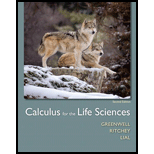
Calculus For The Life Sciences
2nd Edition
ISBN: 9780321964038
Author: GREENWELL, Raymond N., RITCHEY, Nathan P., Lial, Margaret L.
Publisher: Pearson Addison Wesley,
expand_more
expand_more
format_list_bulleted
Concept explainers
Question
Chapter 14.3, Problem 15E
To determine
(a)
To find:
The Equilibrium point of the given equation.
To determine
(b)
To find:
The value of the derivative of the function at the equilibrium points.
To determine
(c)
The stability of equilibrium points tells about each of the equilibrium points.
To determine
(d)
To find:
The next five values of the sequence and determine whether the equilibrium points are stable or unstable.
To determine
(e)
To find:
The behavior of the successive iterations found part d.
To determine
(f)
To find:
The behavior found in part d relates to the results from part c.
Expert Solution & Answer
Want to see the full answer?
Check out a sample textbook solution
Students have asked these similar questions
Explain the key points of 11.5.2
Explain the key points of 11.3.5
Practice using 11.5.2 to derive 11.6.1
Chapter 14 Solutions
Calculus For The Life Sciences
Ch. 14.1 - YOUR TURN 1 Find the first four terms of the...Ch. 14.1 - Prob. 2YTCh. 14.1 - Prob. 3YTCh. 14.1 - Prob. 4YTCh. 14.1 - Prob. 1ECh. 14.1 - Prob. 2ECh. 14.1 - Prob. 3ECh. 14.1 - Prob. 4ECh. 14.1 - Prob. 5ECh. 14.1 - Prob. 6E
Ch. 14.1 - Prob. 7ECh. 14.1 - Prob. 8ECh. 14.1 - Prob. 9ECh. 14.1 - Prob. 10ECh. 14.1 - Prob. 11ECh. 14.1 - Prob. 12ECh. 14.1 - Prob. 13ECh. 14.1 - Prob. 14ECh. 14.1 - Prob. 15ECh. 14.1 - Prob. 16ECh. 14.1 - Prob. 17ECh. 14.1 - Prob. 18ECh. 14.1 - Prob. 19ECh. 14.1 - Prob. 20ECh. 14.1 - Prob. 21ECh. 14.1 - Prob. 22ECh. 14.1 - Prob. 23ECh. 14.1 - Prob. 24ECh. 14.1 - Ricker Model Another model of population growth...Ch. 14.1 - Prob. 26ECh. 14.1 - Prob. 27ECh. 14.1 - Beverton-Holt Model Another model of population...Ch. 14.1 - Prob. 29ECh. 14.1 - Prob. 30ECh. 14.1 - Shepherd Model The Shepherd model, a modification...Ch. 14.1 - Prob. 32ECh. 14.1 - Prob. 33ECh. 14.2 - Find equilibrium points x, 0x1, for each of the...Ch. 14.2 - Prob. 2ECh. 14.2 - Prob. 3ECh. 14.2 - Prob. 4ECh. 14.2 - Prob. 5ECh. 14.2 - Prob. 6ECh. 14.2 - Prob. 7ECh. 14.2 - Prob. 8ECh. 14.2 - Prob. 9ECh. 14.2 - Prob. 10ECh. 14.2 - Prob. 11ECh. 14.2 - Prob. 12ECh. 14.2 - Prob. 13ECh. 14.2 - Prob. 14ECh. 14.2 - For each of the following functions, already...Ch. 14.2 - Prob. 17ECh. 14.2 - Prob. 18ECh. 14.2 - Prob. 19ECh. 14.2 - Prob. 20ECh. 14.2 - Prob. 21ECh. 14.3 - Prob. 1YTCh. 14.3 - Prob. 1ECh. 14.3 - Prob. 2ECh. 14.3 - Prob. 3ECh. 14.3 - Prob. 4ECh. 14.3 - Prob. 5ECh. 14.3 - Prob. 6ECh. 14.3 - Prob. 11ECh. 14.3 - Prob. 12ECh. 14.3 - Repeat the instruction of Exercise 11 for the...Ch. 14.3 - Prob. 14ECh. 14.3 - Prob. 15ECh. 14.3 - Prob. 16ECh. 14.3 - Prob. 17ECh. 14.3 - Prob. 18ECh. 14.3 - Prob. 19ECh. 14.CR - CONCEPT CHECK For Exercise 1-8 determine whether...Ch. 14.CR - Prob. 2CRCh. 14.CR - Prob. 3CRCh. 14.CR - Prob. 4CRCh. 14.CR - Prob. 5CRCh. 14.CR - Prob. 6CRCh. 14.CR - Prob. 7CRCh. 14.CR - Prob. 8CRCh. 14.CR - Prob. 9CRCh. 14.CR - Prob. 10CRCh. 14.CR - Prob. 11CRCh. 14.CR - Prob. 12CRCh. 14.CR - Find the next 4 terms of the sequence satisfying...Ch. 14.CR - Prob. 14CRCh. 14.CR - Prob. 15CRCh. 14.CR - Prob. 16CRCh. 14.CR - Prob. 17CRCh. 14.CR - Prob. 18CRCh. 14.CR - Prob. 19CRCh. 14.CR - Prob. 20CRCh. 14.CR - Prob. 21CRCh. 14.CR - Prob. 22CRCh. 14.CR - Prob. 23CRCh. 14.CR - Prob. 24CRCh. 14.CR - For each of the following functions, do the...Ch. 14.CR - Prob. 26CR
Knowledge Booster
Learn more about
Need a deep-dive on the concept behind this application? Look no further. Learn more about this topic, calculus and related others by exploring similar questions and additional content below.Similar questions
arrow_back_ios
SEE MORE QUESTIONS
arrow_forward_ios
Recommended textbooks for you
 College Algebra (MindTap Course List)AlgebraISBN:9781305652231Author:R. David Gustafson, Jeff HughesPublisher:Cengage Learning
College Algebra (MindTap Course List)AlgebraISBN:9781305652231Author:R. David Gustafson, Jeff HughesPublisher:Cengage Learning

College Algebra (MindTap Course List)
Algebra
ISBN:9781305652231
Author:R. David Gustafson, Jeff Hughes
Publisher:Cengage Learning

01 - What Is A Differential Equation in Calculus? Learn to Solve Ordinary Differential Equations.; Author: Math and Science;https://www.youtube.com/watch?v=K80YEHQpx9g;License: Standard YouTube License, CC-BY
Higher Order Differential Equation with constant coefficient (GATE) (Part 1) l GATE 2018; Author: GATE Lectures by Dishank;https://www.youtube.com/watch?v=ODxP7BbqAjA;License: Standard YouTube License, CC-BY
Solution of Differential Equations and Initial Value Problems; Author: Jefril Amboy;https://www.youtube.com/watch?v=Q68sk7XS-dc;License: Standard YouTube License, CC-BY